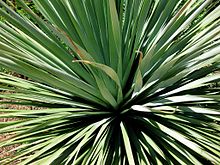- Nolina nelsonii
-
Nolina nelsonii 
Scientific classification 
Kingdom: Plantae clade: Angiosperms clade: Monocots Order: Asparagales Family: Asparagaceae Subfamily: Nolinoideae Genus: Nolina Species: N. nelsonii Binomial name Nolina nelsonii
RoseNolina nelsonii (Blue Nolina or Nelson's Bear Grass), often misspelled Nolina nelsoni, is a flowering plant in the genus Nolina. The species was first described in 1906[1]; in its genus, it is morphologically most similar to Nolina parryi. This extremely drought-tolerant plant is native to the deserts and montane regions in northern/northeastern Mexico. It is known to be cold-hardy to at least -12 ºC. It develops a trunk mesuring from one to several meters high, making it an arborescent member of its genus. The bluish-green leaves, with finely toothed margins, are borne in dense rosettes, each with up to several hundred stiff linear (narrow) leaves up to 70 centimeters long[2]. It is dioecious; upon reaching sexual maturity, its white-flowered inflorescence appears in Spring. The fruit capsules are around 80 mm in length, containing light-brown, spherical to oblong seeds 2-3 mm in diameter. After blooming, the plant's main trunk dies and multiple lateral trunks emerge to take its place.
References
- ^ Contributions From the United States National Herbarium. Volume 10, 1906, p. 92
- ^ http://de.wikipedia.org/wiki/Nolina_nelsonii German Wikipedia
External links

This Asparagales article is a stub. You can help Wikipedia by expanding it.
